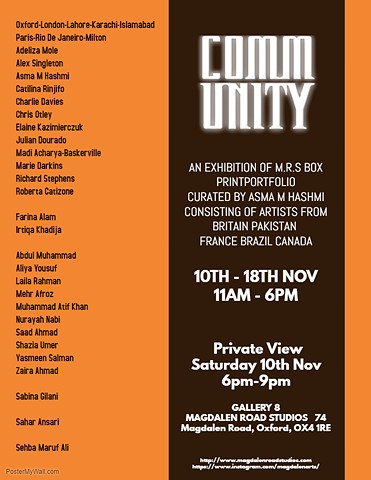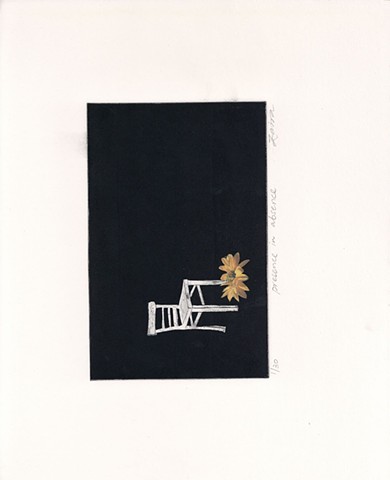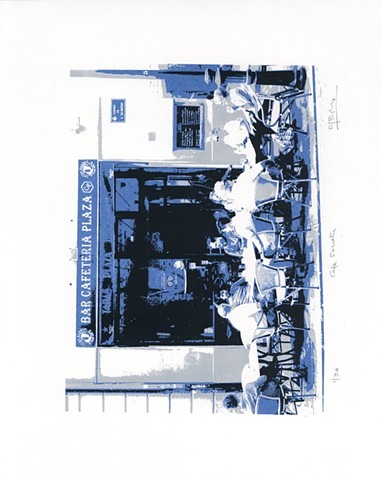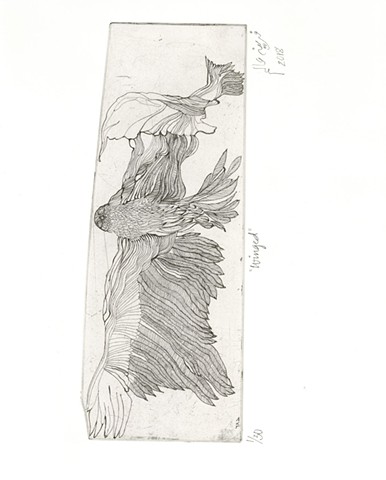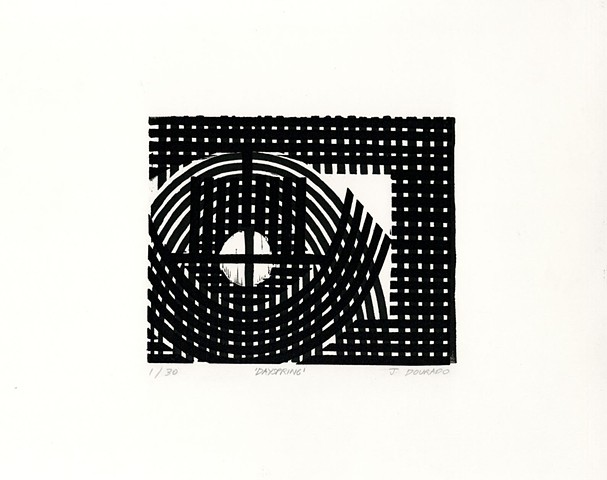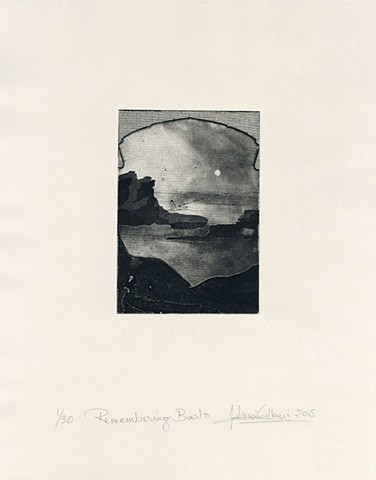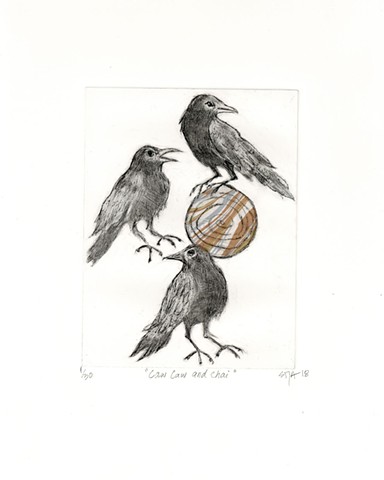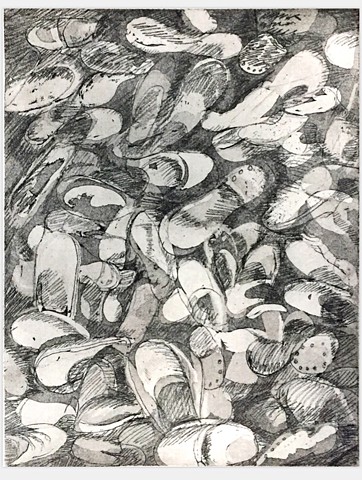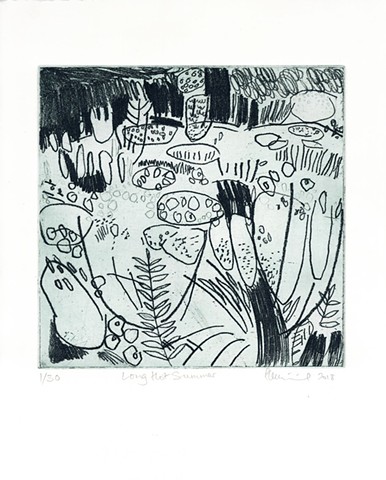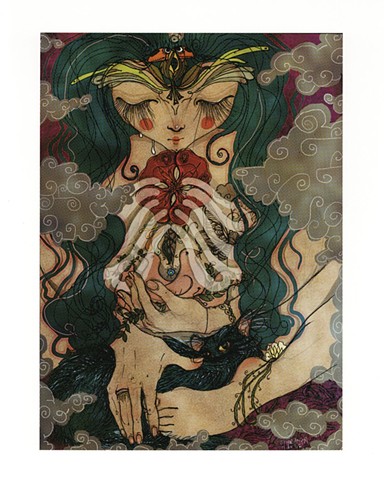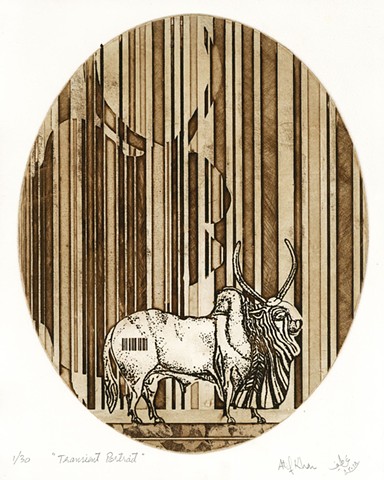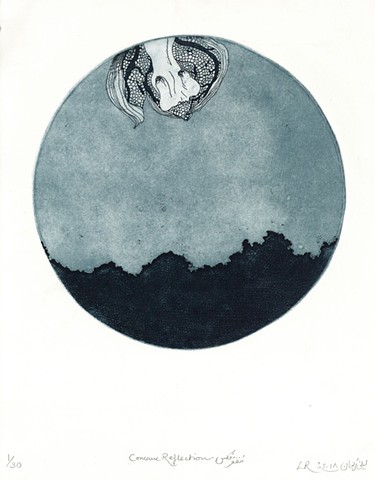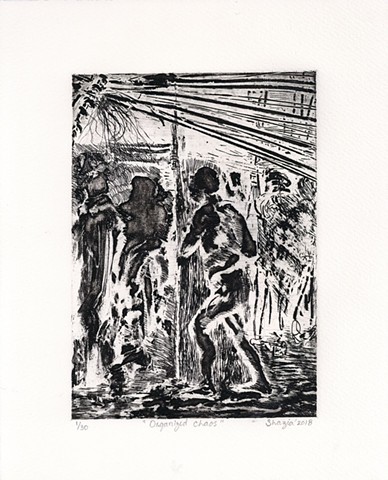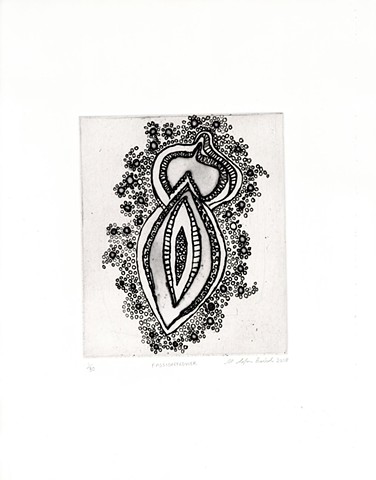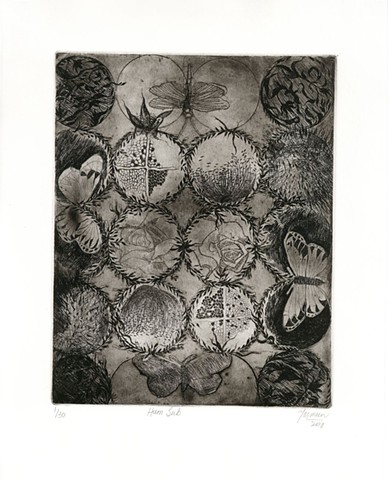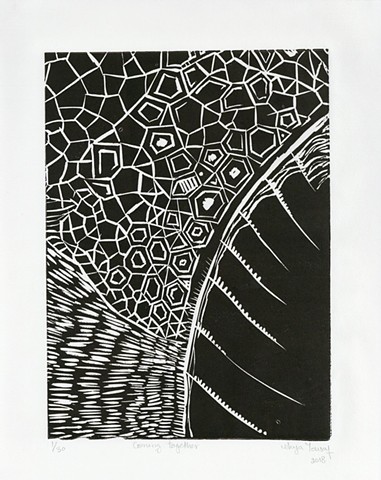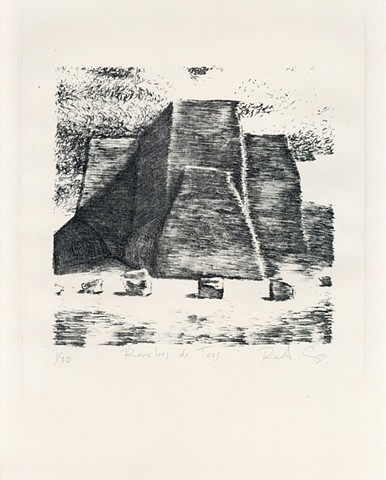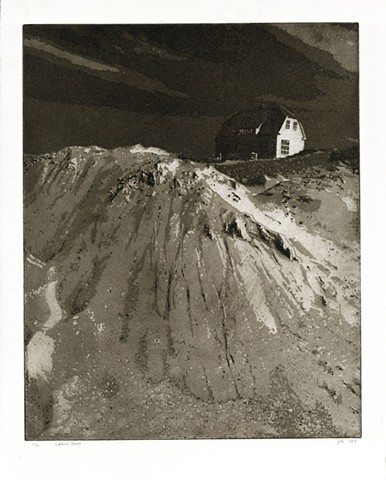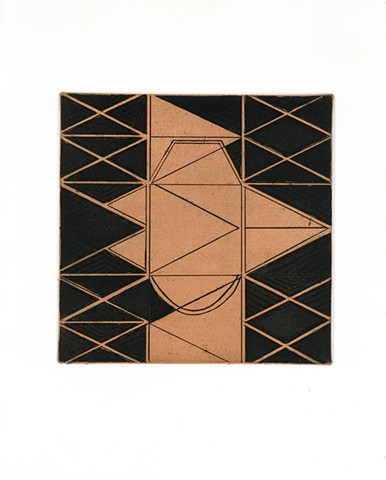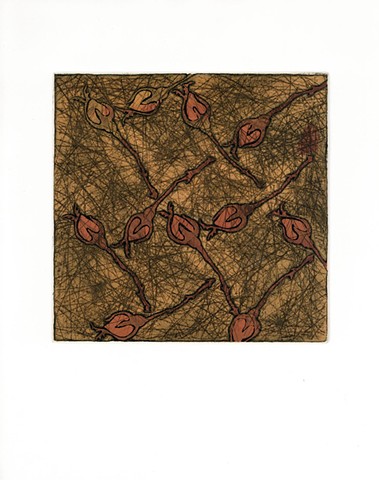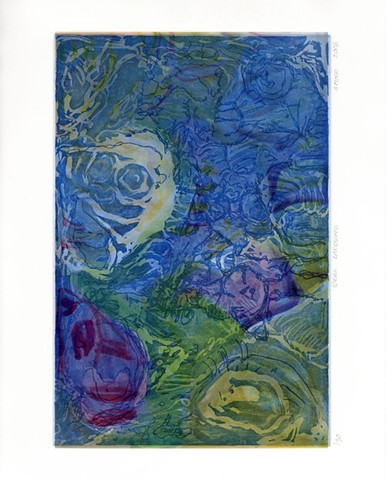Magdalen Road Studio Box PrintExchange 'CommUnity'
CommUnity - Exhibition Statement
Community is made both complex and elusive by many aspects of current life and culture. Internet platforms connect yet segregate us. Migration invites exchange yet alienation. One’s place among others is increasingly removed from physical location. Urban density increases both proximity and anonymity.
CommUnity print exchange proposes to simplify community. What is our obvious commonality? How immediately and tangibly can it be felt?
These artists faced these questions in various ways through their responses to this event. The very nature of this exchange creates a gathering of individuals from a variety of distant locations into a community through common art practices. The work culminates both in a public viewing of the show as a whole in a single gallery, and in the concept of box portfolio - the lasting distribution of the full print collection to each of the participants. The value of this collection is unique. Each edition contains hand signed and numbered prints, one of which is the owner’s own work. The artists are literally together within it.
Where will each collection live within the life, work, and homes of these printmakers? What correspondences may continue between artists sharing the same collections? One imagines spending years visiting and revisiting, say, a particularly cherished print, with the added depth of knowing that same artist holds the collection as well, including one’s own piece. Many of these printmakers were previously unfamiliar to each other, and are now present in each other’s work and histories in a most tangible way.
Artist and curator Asma M Hashmi was careful to honour the spontaneity and honesty of each participant’s response to the theme of Community. Confident that the process itself would inevitably reflect on community, given the shared medium and destination for showing, Hashmi simply and generously posed the theme and encouraged open-ended response. She fostered space for the potential for variety and commonality, and perhaps coincidence, among diverse artists practicing similar media.
Questions of community are complex. Even at the very local level of one individual’s creative response to a medium, there is a reckoning with others - fellow artists past or present who have inspired or challenged, friends or family members navigating around support and solitude, professional associates, imagined or real viewers … An artist may accept or even insist upon a certain distance from others for the sake of their intimate engagement with a medium. The art itself simply demands this often enough. Yet there are deep and widespread personal connections stirred by and around the results of this independent work.
By gathering around this print collection, as the artists themselves gathered around the theme, and as the physical copies of the collection are gathered ultimately, we embrace the potential to distinguish ourselves, via independent community, from a larger global political picture of divisiveness and separation. The potential of individuals and spontaneous community to reflect cooperation, support, and commonality is an important counter here. The exhibition site of Oxford, with its strong South Asian population, offers a reflection of migration and exchange between England and South Asia. Known challenges of migration and exchange on the large scale, particularly poignant in this moment of Brexit on one side of the Atlantic and Trump on the other, are answered through the organic potential of the community scale when we seek to engage it.
The artists in CommUnity have common practices, each expressed uniquely. They have gathered their works without necessarily knowing each other, into something we can all know, and through it, know each other.
COMMUNITY AND CONVERSATION
Quddus Mirza
The art of printmaking has multiple facets. At one point, you sacrifice your existing diction (due to unlimited availability/possibility of picture making), on the other hand the technique entices you to numerous effects offered within the genre. Several of well-known artists working in this medium, are usually attracted to textures, impressions and accidental results. As envisaged, normal and natural, since sometimes process takes over, and what left is this fascination, resulting in a few blobs, bites, and scratches on grainy surface. Amazing in terms of their retinal appeal, but can be enjoyed on other levels, too.
At the same instance the discipline suffices a range of approaches for artists, mainly for those who have been associated with, or others, recognized for their works in other formats. To all of them the medium of printmaking becomes a point to think, experiment, embark and take risk, often negating one’s usual practice and familiar production of art.
Printmaking, as explained by Karachi based curator and writer, Zarmeene Shah, is “… one of the oldest forms of expression in the world, with engraving (or etching) techniques dating back thousands of years to cave art, executed on walls, bone, and stones”; however, in today’s sensibility it is identified with hard work – almost labour. The process of preparing a plate, inking, wiping, and putting it in press for multiple editions is a tough task. Yet a number of artists manipulate the medium to attain their particular vision. Example are seen in the prints included in ‘Community’, inviting artists from Britain, Pakistan, France, Brazil and Canada.
Curated by Asmaa M. Hashmi, the project involves artists of diverse backgrounds. Thus, their works – become a point of conversation; dialogue using the vocabulary of visual means. A much-needed course in a world experiencing globalization on one side, and at the same time transforming the globe into small islands of isolations. Regions are split, not in a literal or physical sense, but in political, ethnical and religious contexts. Groups, communities, and societies safeguard their geographical and metaphysical territories, on the name of nationalism, ideology, and identity. Turning inhabitants of one region, state, street into enemies, bent on annihilating and destroying one and other.
In this situation and scenario, probably, the pictorial art – presumably a mute medium, may serve to resume a discourse among different individuals. As distant an artist from Brazil can be from an artist living on France. Or a printmaker practising in UK, would be from the one working in Pakistan. But despite of these distances one feels that there is hardly a rift among artists participating in this project. Mainly because, though they live in London, Oxford, Paris, Lahore, Karachi and Islamabad, they belong to a common republic, we call the realm of art. Where the disparities of passports yield to passions for expression. In this land, it is not important, where an artist comes from, but where he/she is heading to is more crucial, rather essential, because making a work of art is a means of boarding – short distance or long haul – train of ideas/imagery. Accompanying viewers in those sojourns. To unknown destinies, to unseen destinations.
The more an artist moves and takes his audience along, the more he realizes that the longest routes end at the threshold of one’s self. Since art is a mirror, in which not only an individual is reflected, but an entire society is represented, to be recognized by itself. The works in the exhibition offer that varied mirrors to know ourselves, our surroundings and our circumstances. Artists have taken multiple paths to suggest what is personal yet public, poetic yet pragmatic, private yet popular.
So a man-bird of Alex Singleton, view of “common land known as Padworth lawn” by Adeliza Mole, stem of flowers by Charlie Davies, butterflies drawn by Yasmeen Salman, leaves in the print of Nurayah Sheikh Nabi, organic forms made by Elaine Kazimierczuk, Sahar Ansari, Laila Rahman and Farina Alam confirm the artists’ observation and command on transforming the world of visual into modes for transcendence, both actual and conceptual. Liberating from one’s limitation and to roam in the world of dreams and fantasy. These works convey a merger between reality and imagination.
A similar phenomenon is observed when we look at the samples of geometry; which is a method of translating nature into order. Bringing diversity and spontaneity into structure and system. The history of art is a chronicle of taming organic into mechanical and infusing a sense of spirituality and sublime in these simple and stark shapes. Examples of this approach are visible in the prints of Catalina Renjifo, Aliya Yousuf, and Julian Dourado. Along with these a number of participants produced works which evoke a warmth that seems so near, reachable and immediate. The interior with two figures by Saad Ahmed, a single woman by Irtaqa Khadija, men in a busy environment by Shazia Umer, a chair trampling a sunflower on floor by Zaira Ahmad Zaka, view of a crowded café by Richard Stephens, all denote how human beings survive as well as enjoy in the world built by them.
Beyond – and prior to that world, mankind has also confronted the vastness of nature. Something that still haunts humans, despite of development in science, technology and mechanical means. A storm on the cost of USA, flood in Italy, earthquake in Indonesia claim many lives – besides proving supremacy and power of nature, even in the twenty-first century. A number of printmakers have contemplated on this interaction between man and nature, or humans and their surroundings. A single house perched on top of a cliff (Chris Otley), mysterious construction from seemingly from a past away of mainstream narrative (Roberta Catizone) and a lyrical landscape of Sabina Gilani that, more than a view outside one’s window, represents one’s feelings, emotions and senses; suggest attempts in investigating and modifying nature.
A number of artists have picked specific subjects/visuals to denote their ideas, for example Atif Khan has drawn bull from the seals of Indus Valley Civilization, thus connecting a link among traditions of image making that spanned almost 5 thousand years. Madi Acharya-Baskerville has focused on “objects, textiles, song, conversation and magazine cuttings which resonate with her on some level” and “she creates works which move fluidly between different media” so the work which reminds of conventional textile patterns, also connotes to the reproductive organ of a woman’s body. The element of body is seen as a metaphor in the work of Mehr Afroz, with two vests placed side by side, but reminding of an absent human body. The contours, swelling and stretch of the cloth imply the existence of a living entity, but the work – in actuality survives on the boundary between life and memory of life.
Life is shown in other symbolic schemes too. For instance, plant form in Asmaa M. Hashmi’s print The Devil is in the Detail signifies political situation on the boundary of two countries. This politically charged work, that has a strong personal aesthetic quality, indicates the way form and content coexist side by side and simultaneously. The notion of duality is further observed in the way Sehba Maruf has composed birds (crows, ravens) around a circular form; or how Abdul Muhammad’s two birds are joined as if replica images of each other, yet looking like kissing or conversing.
The preference for birds in an exhibition of art, is more than merely portraying a species, because these creatures signify a human aspect. The way they are in close contact, echoes human interaction (kiss, conversation); so all the works selected for the project, and especially these two – with birds being the main motif – bring back The Conference of the Birds by Farid ud Din Attar. About flight of birds who leave their nests to meet their king, towards the end of their lives realizing that king is their own creation that has captivated them.
In a project like this, which has influenced and altered the styles, customs and comforts of all artists, the compilation of art pieces is called a box print, but it could have been described The Conference of the Birds too, since prints of all participants are in close conversation with each other. A unique opportunity and meeting point across ages, standards and sensibilities, backgrounds, regions, countries, and continents.
Quddus Mirza is an artist, art critic and independent curator. He is the Professor of Fine Art and the Head of Fine Arts Department at the National College of Arts Lahore. Mirza has shown extensively in numerous important group exhibitions, along with several one-person exhibitions, held in Pakistan and UK. He has also curated a number of exhibitions in Pakistan, UK and India. Mirza is an art critic with a regular weekly column appearing in Pakistan’s major newspaper, ‘The News’, and regular column on art Letter from Pakistan in ‘Art India’ and in ‘Depart’ (Bangladesh) as well as contributing to other publications like ‘Dawn’, ‘Herald’, ‘Himal’, ‘Libas’, ‘Contemporary’ and ‘Flash Art’.
He is the co-author of book “50 Years of Visual Arts in Pakistan” and has extensively written essays on Pakistani art in different international catalogues and other publications. He is also the editor of online magazine ‘Art Now Pakistan’.

